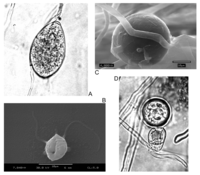
Photo from wikipedia
Late blight disease, caused by the plant pathogen Phytophthora infestans, is one of the major threats for tomato and potato crops. Monitoring the populations of P. infestans is important to… Click to show full abstract
Late blight disease, caused by the plant pathogen Phytophthora infestans, is one of the major threats for tomato and potato crops. Monitoring the populations of P. infestans is important to determine if there are changes in the sensitivity to fungicides and host preference. In this study, microsatellite markers and mitochondrial haplotypes were used to assess the genotype of isolates of P. infestans collected from tomato and potato plants in Colombia. Furthermore, sensitivity to three fungicides cymoxanil (penetrant fungicide), mefenoxam and fluopicolide (systemic fungicides) and tomato-potato host preference were evaluated. Mitochondrial haplotyping showed that isolates collected on tomato were from the genetic groups Ia and Ib, while isolates collected on potatoes belonged to group IIa. Microsatellite analyses showed that isolates from tomato form two groups, including the Ib mitochondrial haplotype which is genetically close to the US-1 clonal lineage and the Ia haplotype related to the EC-3 lineage, whereas Colombian isolates from potato formed a separate group. Furthermore, differences in sensitivity to fungicides were observed. Eighty-one percent of the isolates tested were resistant to mefenoxam with an EC50 value greater than 10 µg mL-1. Forty-two percent of the isolates showed an intermediate resistance to cymoxanil. The EC50 values ranged between 1 to 10 µg mL-1. For fluopicolide, 90% of the isolates were sensitive with EC50 values less than 1 µg mL-1. Host preference assays showed that potato isolates infected both host species. Thus, isolates that infect potatoes may pose a risk for tomato crops nearby.
Journal Title: Phytopathology
Year Published: 2022
Link to full text (if available)
Share on Social Media: Sign Up to like & get
recommendations!